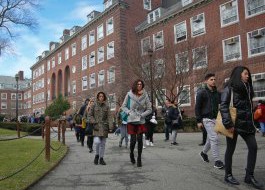
The number of foreign students in American schools has been surging over the past decade, and numbers are up again, according to newly released data from the US Department of State's Bureau of Educational and Cultural Affairs and the Institute of International Education (IIE).
Foreign students in the US were up 7.1% from last year with 1,043,839 students total, and international students now make up 5.2% of all higher education students in the US.
China, India, and Saudi Arabia were the top three countries which send the most students to American schools.
But as more international students attend US schools, questions about preserving the integrity of American institutions, driven by reports of the challenges, will likely abound.
For example, foreign students studying at US universities were seen to cheat more than American students, according to a Wall Street Journal analysis.
Citing data from 14 large public universities, The Journal noted that public universities recorded 5.1 reports of alleged cheating per 100 international students, compared to one report of cheating per 100 American students.
The Journal requested data from 50 different public universities with student bodies heavy with foreign enrollment, though only 14 were able to provide complete data for the 2014-15 academic year.
 Facebook/wheatoncollege.il
Facebook/wheatoncollege.il
At nearly every school, reports of cheating involving foreign students were twice as high, ranging up to as much as eight times as high at some institutions.
Faculty interviewed about the phenomenon attributed it to the fact that foreign students either don't understand or accept US standards of academic integrity, according to The Journal.
But responses varied on why standards of academic integrity differed between American and foreign, especially Chinese, students.
"In China, it's OK to cheat as long as you're not caught," Lanqing Wang, a Georgia Institute of Technology student originally from Shanghai, told The Journal.
Others weren't as willing to say that cheating was acceptable in China and, instead, pointed to intense pressure to succeed.
"In China, our culture puts a lot of pressure on students," Paidi Shi, vice president of a Chinese student group at the University of California at San Diego, said. "We are more likely to find a shortcut to get a good grade."
Still, others attributed at least some of the issue to the fact that cheating may be more obvious in foreign students.
For example, if a foreign pupil with poor written English suddenly turns in a perfect paper, then a professor would likely scrutinize it more than if an American student did so, even if the American student had plagiarized.

The Journal's analysis isn't the first time reports about cheating being common among Chinese students have surfaced. Law-enforcement officials have recently investigated test-taking scams where Chinese students hire testing proxies to take tests like the SAT or GRE.
In 2015, more than a dozen current and former US college students from China were arrested and pleaded guilty to participating in such a cheating scheme, according to The Hechinger Report.
Still, despite concerns about preserving the integrity of American institutions, the influx of foreign students is vital for American universities, and especially public universities, which have become increasingly dependent on foreign students to fund their budgets.
International students actually pay up to three times more than in-state students at public universities, effectively subsidizing education costs for other students at many universities, Business Insider's Tanza Loudenback reported in September citing data from SelfScore, a company providing financial services to international students.
"In 2015, the country's public universities gleaned more than $9 billion in tuition and fees from foreign students, according to SelfScore's analysis," Loudenback wrote. "That's about 28% of annual tuition revenue coming from foreign students, who make up an average of just 12% of the student population."
Schools will likely continue to balance their need for foreign students with the desire to keep programming rigorous as the student body populations continue to become more diverse.




